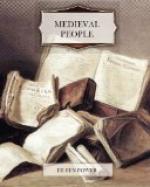were inconceivably complicated by the exchanges.
We think we know something about the difficulty of
divers and fluctuating exchanges today, but we can
hardly imagine the elaborate calculations and the
constant disputes which racked the brain of a Merchant
of the Staple in the fifteenth century. Not only
did the rates between England and the Continent constantly
vary, but, as the editor of the
Cely Papers
points out, ’the number of potentates of all
kinds who claimed the privilege of issuing their own
coinage and the frequently suspicious character of
what they uttered as gold and silver, made the matter
of adjustment of values difficult for the Celys, who
were evidently obliged to take what they could get.’[67]
Only imagine the difficulties of poor Thomas Betson,
when into his counting-house there wandered in turn
the Andrew guilder of Scotland, the Arnoldus gulden
of Gueldres (very much debased), the Carolus groat
of Charles of Burgundy, new crowns and old crowns
of France, the David and the Falewe of the Bishopric
of Utrecht, the Hettinus groat of the Counts of Westphalia,
the Lewe or French Louis d’or, the Limburg groat,
the Milan groat, the Nimueguen groat, the Phelippus
or Philippe d’or of Brabant, the Plaques of Utrecht,
the Postlates of various bishops, the English Ryall
(worth ten shillings), the Scots Rider or the Rider
of Burgundy (so called because they bore the figure
of a man on horseback), the Florin Rhenau of the Bishopric
of Cologne and the Setillers.[68] He had to know the
value in English money of them all, as it was fixed
for the time being by the Fellowship, and most of
them were debased past all reason. Indeed, English
money enjoyed an enviable good fame in this respect
until Henry VIII began debasing the coinage for his
own nefarious ends. The letters of the Celys are
full of worried references to the exchange, and much
we should pity Thomas Betson. But doubtless he
was like Chaucer’s bearded merchant: ‘Wel
koude he in exchaunge sheeldes [French crowns] selle.’
[Illustration: VII. CALAIS ABOUT THE TIME
OF THOMAS BETSON]
To effect their payments between England and the Netherlands
the staplers used to make use of the excellent banking
facilities and instruments of credit (bills of exchange
and so forth), which were placed at their disposal
by Italian and Spanish merchants and by the English
mercers, all of whom combined trading with financial
operations. Thus we find William Cely writing
to his masters:
[Illustration: VIII. THOMAS PAYCOCKE’S
HOUSE AT COGGESHALL]
Please your masterships to understand that I have
received of John Delowppys upon payment of the bill,
the which is sent me by Adlington but L300 fleming,
whereof I have paid to Gynott Strabant L84 6s. 6d.
fleming. Item, I have made you over by exchange
with Benynge Decasonn, Lombard, 180 nobles sterling,
payable at usance. I delivered it at 11s.
2-1/2d. fleming the noble, it amounteth L100 17s.




